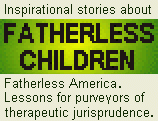BIAS

The URL for this webpage is http://www.thelizlibrary.org/liz/011.htm
The single most overwhelming feature of parenthood in Disney nouveau
is the almost total absence of the mothers. They are absent in far
greater numbers than either renaissance fathers or mothers of the pre-Mermaid
era. In fact, with only a single exception (Mulan), every single relevant
major character in Disney's recent major releases either loses his or her
mother in infancy, or is permanently separated from her during or before
childhood, or simply has no onscreen mother at all. [Update 2012: In an interesting later
deviation, the propaganda is even worse. In "Tangled", a distortion of
the Rapunzel fairy tale, the girl's captor is given a stereotyped
wicked single mother persona. She is the only truly evil character. An ostensible girl-power
twist makes Rapunzel a stolen princess who at first smacks around the scofflaw ne'er-do-well who
does very little to rescue her,
instead of the child of married
peasants who sold their baby, who later is saved by and marries the prince.]
http://www.petersnet.net/research/retrieve.cfm?RecNum=4306
http://www.imdb.com/title/tt1222815/news
http://www.suite101.com/article.cfm/5974/101505
| Dallas Morning
News had a long article about the skepticism (and hostility) battered women
face in Dallas County's family courts. The article offers unusual, if dismaying,
candor by family court judges. Among other frightening rulings, the judges
have reacted to a law that prohibits giving an abuser joint custody by
giving abusers full custody...
Abuse in the system: Courts
fail to protect custody rights of battered spouses; judges call rulings
fair
05/12/98
by Kendall Anderson
The Dallas Morning News
Annette Travi and Kelly Abernathy say
the beatings they'd suffered had taught them the meaning of pain. But that
was before they got to divorce court and lost custody of their children
to the men they say abused them. . .
originally published on the
web at: http://www.dallasnews.com/metro-dfw-nf/dfw12.htm
|
http://hsx.sagepub.com/cgi/content/abstract/13/1/21?etoc
Homicide Studies, Vol. 13, No. 1, 21-49 (2009)
University
of Central Florida, srtaylor-at-mail.ucf.edu
Slain and Slandered
A Content Analysis of the Portrayal of Femicide in Crime News
by Rae Taylor
 The
present study is a content analysis of crime news to determine how femicide
victims are portrayed by a Florida metropolitan newspaper. The analysis
consisted of 292 domestic homicide-related articles published by one newspaper
from 1995 to 2000. The data were analyzed to determine effects on newsworthiness,
context revealed, and patterns of victim blame. A dichotomy concerning
victim blame emerged from the analysis, suggesting victims are blamed
directly and indirectly for their own femicides. Direct tactics include
using negative language to describe the victim, highlighting her choices
not to report past incidences, and portraying her actions with other men
as contributing to her murder. Indirect tactics include using sympathetic
language to describe the perpetrator; emphasizing the perpetrator's
mental, physical, emotional, and financial problems; highlighting the victim's
mental or physical problems; and describing domestic violence in terms
that assign equal blame to both partners.
The
present study is a content analysis of crime news to determine how femicide
victims are portrayed by a Florida metropolitan newspaper. The analysis
consisted of 292 domestic homicide-related articles published by one newspaper
from 1995 to 2000. The data were analyzed to determine effects on newsworthiness,
context revealed, and patterns of victim blame. A dichotomy concerning
victim blame emerged from the analysis, suggesting victims are blamed
directly and indirectly for their own femicides. Direct tactics include
using negative language to describe the victim, highlighting her choices
not to report past incidences, and portraying her actions with other men
as contributing to her murder. Indirect tactics include using sympathetic
language to describe the perpetrator; emphasizing the perpetrator's
mental, physical, emotional, and financial problems; highlighting the victim's
mental or physical problems; and describing domestic violence in terms
that assign equal blame to both partners.
|
| A survey of divorced,
Philadelphia-area women found that 70% were abused by their spouses.
Nineteen
percent cited the violence as their primary reason for leaving the marriage.
Fifty-four
percent had suffered several incidents of violence and sustained injury
from their ex-husbands.
Even
after separation, nearly one-half of the women experienced violence from
their estranged husbands.
Not
surprisingly, 30% feared further violence during child support negotiations,
and, of this subset, 66% did not receive regular child support payments
(Kurz,
Demie. (1996). "Separation, Divorce, and Woman Abuse."
Violence Against Women, 2(1): 63-81.)
|
Gelles,
R.J. (1996)
The Book of David: How Preserving Families Can Cost Children's Lives.
New York: Basic Books. ISBN: 0-465-05395-5
|
from
a listserve discussion prompted by
ADOPTION & FOSTERING, VOLUME 22, NUMBER 1, 1998, PAGE 24-30
**Adoption and adjustment in adolescence**: |
liz: Did
the authors hypothesize why the children might have had more problems than
in intact birth families?...
|
| RZ: I
think the ultimate point is that although adopted children in two parent
households did worse than intact 2 parent biological families, they did
better than children in blood related single parent families. The research
[other research somewhere, apparently] consistantly shows
single parent families as not conducive to child welfare. |
liz:
I
must have missed that point... this research found a significant
difference between two-parent birth homes and two-parent adopted homes.
However, the socio-economically advantaged, two-parent adoptive homes performed
only marginally better than poor, unwed single mother homes in the control
group. That indicates that it's not two parents that count but other factors.
[Is it sperm?]
"In
particular, children placed in adoptive families had rates of externalising
behaviours (including conduct disorders, juvenile offending and substance
use behaviours) that were significantly higher than children reared in
two-parent birth families but somewhat lower than those of children who
entered single-parent families at birth." -- David Fergusson is Associate
Professor, Christchurch Health A Development Study, Christchurch School
of Medicine, New Zealand
|
| EB:
I think it is clear that the study is implying that children do worse
in single parent homes. |
liz:
The synopsis posted here doesn't imply that at all. If you've read
the study, perhaps you could share where it differed from the synopsis.
|
| EB:
[snarkily] Interesting... you'd think that the abandonment issues
early on would have more of an impact than the effect of having just one
parent... |
liz:
The synopsis said that these were adoptions from time of birth. [This
group of adoptees were chosen in order to control for those possible other
factors.]
|
| EB:
Easy to generalize -- but it does bring home the point of how difficult
it is for children to live with only one parent. Whether that be
because of how difficult it is for the parent to cope, or because of the
absence of the other parent... who knows... |
liz:
Widowed households show child-rearing outcomes similar to intact two-parent
homes... I wonder how it much hurts children's feelings and harms their
self-esteem to live in a world in which they constantly are told how abnormal
their family is. What do you think?
|
| RZ:
Should we also keep adopted children ignorant of their adoption because
of the low esteem factor involved in learning that your mother gave you
away and your father did nothing to stop her? |
liz: The
vast difference between this situation and the constant message about their
abnormal families given to children of single parents is that society at
large does not know whether any given child has been adopted, that there's
an easy counter to the rejection issue in the "we chose you"
response, and that the adopted home is in all other ways indistinguishable
from the blood-issue home.
|
| RZ:
Perhaps we should all live in ignorance about the negative effects of
single parenthood, especially since, barring a spouses death, most single
parent situations are a result of adult choices made for the kids who have
no such choice. |
liz:
The only negative effect that can be said to directly and always trace
from a child's having one parent versus two is the effect of society's
constant negative and demeaning messages, not only about the circumstances
but also impliedly about the child's parents. No other "effect"
of single parent homes has been proved to be related per se to the fact
that a child lived in a home with one parent rather than two. That
there is only one parent bespeaks of a multitude of other factors
that are creating negative outcomes and which are more likely to be found
in single parent homes. [For more on this issue, see 017.htm]
|
| EB:
liz, you and I go far back arguing about whether children need a father
in their life -- I would guess that your position here is that children
do just fine with just a mom -- is that what you are trying to argue here? |
liz:
EB, You're the one who is genderizing this. Not me.
Children
need ONE parent. Two is gravy. Not a "need." However, BOTH kinds
of families, one-parent or two-parent (of whatever sex or sexes) can provide
a whole and wholesome and nurturing environment for raising children.
Because
the two-parent man-woman intact home is the ideal in our society, and is
a structure more easily supported by it, that arrangement may be socially
and financially easier for the primary caregiver. But that holds
true ONLY if there's a supportive marital partner in the residence. Nothing
and no research indicates that children benefit from two parents when those
parents do not live together in a functional marriage.
Moreover,
when a two-parent home breaks up from divorce, it is likely that this particular
two-parent home is NOT better in that particular case.
When
the relationship between the parents is gone, the very thing that makes
an intact two-parent household the social ideal it is (love, cooperation,
support from father to mother, husband/wife role models, etc.) also is
GONE. Gone forever. Period. Ended. Kaput.
In
such cases, the next best alternative, and the only appropriate choice,
is a stable, intact one-parent home. Nothing is to be gained by personalizing
this; it's not about your husband or father... another family's version
of "Dad" may be a drunk who comes home at 10 p.m. and starts
throwing chairs... your personal version (and clouded vision) might be
better, but that one isn't.
It's
also better to live in a home with a high income. Shall we start
a campaign bashing working class families and their child-rearing outcomes?
or how about setting up demographic studies by... ethnic group? religion?
and start comparing. Let's compare how Southern Baptist homes do
versus Jewish homes on graduate school attendance. Maybe we can make
a case to trash one religion or the other. LET'S BE SURE TO
TELL THE KIDS, TOO. (Don't want to keep ANYTHING from them that was their
parent's choice.)
The
constant denigrating of one-parent households DOES harm children. The
constant blather and blame laid against one-parent homes only makes it
harder for these households to function well, and it accomplishes nothing
toward preserving marriages that are in fact gone. Even the "parental
choice" argument is invalid: some single women likely would have preferred
to have remained or become married, but that simply was not a viable option.
In
a bad marital situation, mothers may make the choice to establish a single
parent home because it is better than the only alternative they have at
hand -- a dysfunctional two-parent home.
Single
parent household bashing is nasty. EB, all those kids you say you talk
to from "fatherless" homes, who supposedly feel bad... especially
where there's not an actual person who is being missed, are you sure it's
not the questions and attitudes of people like you who are creating those
bad feelings?
|
|
[Note:
EB died not too long after this discussion, leaving her children in a one-parent
home.]
|
SAN FRANCISCO (Bay
City News)
August 14, 1998
A child development
specialist at the University of California at San Francisco says young
children who witness domestic violence show an increase in IQ scores when
treated together with their mother.
Alicia Lieberman
presented preliminary findings of the ongoing study at a meeting of the
American Psychological Association today in San Francisco...
Among the findings:
Sixty percent of the children showed IQ increases over pre-treatment
IQ tests. Half of the mothers no longer showed signs of post-traumatic
stress syndrome. And the emotional quality of the child-mother relationship
improved.
The UCSF Child Trauma
Research Project study involved 45 mother-child pairs. All of the women
had suffered severe domestic violence and all of the children, who were
between the ages of 3 and 5, had witnessed the attacks.
Other promising findings,
according to Lieberman, were that only two of the 45 children showed
acute stress at the end of the treatment. And only one mother returned
to the perpetrator during treatment, compared to a common return rate of
50 percent when the mother and child are treated separately...
|
|
INTERVIEW OF
CHRISTOPHE MEILE
FORT LAUDERDALE SUN-SENTINEL
Sunday, May 30, 1999
by Miriam Stawowy
"Swiss Guard called traitor for exposing bank scandal"
Q:
When you firsrt saw those documents that detailed Jewish holdings in the
banks, did you think about what telling would mean?
A:
I knew it would have an impact. But on the other hand, it made more
sense to preserve every evidence. I turned it over to help the Jewish people.
At the time, the World Jewish Congress was pressuring Switzerland to disclose
how much money they had from Jews in Swiss bank accounts...
Q:
What was the initial response?
A:
People were angry that I helped the Jews...
Q:
Why did you speak up and not walk away from those documents about to be
destroyed??
A:
First of all, I'm a Christian. I believe the Bible is
true and that Jesus is the Messiah, the boss. If you take him in
your heart, he'll give you a new life.
 But
I also grew up different than the other kids around me. My parents
divorced when I was 10. I felt discriminated by being in a family
without a father. Maybe this turned me into who I am... But
I also grew up different than the other kids around me. My parents
divorced when I was 10. I felt discriminated by being in a family
without a father. Maybe this turned me into who I am...
I like the openness
of American society. People let you breathe here. In Switzerland
people attack you. They don't like people who are different...
|
SITE INDEX
| LIZNOTES
MAIN PAGE | COLLECTIONS
| WOMENS
HISTORY LIBRARY | RESEARCH ROOMS
| THE READING ROOM
FATHERLESS CHILDREN STORIES
| THERAPEUTIC JURISPRUDENCE
| WOMAN SUFFRAGE
TIMELINE | THE LIZ LIBRARY
ENTRANCE
Except
as otherwise noted, all contents in this collection are copyright 1996-2013
the liz library. All rights
reserved.
This site is hosted and maintained by argate.net
Send queries to: sarah-at-thelizlibrary.org
|